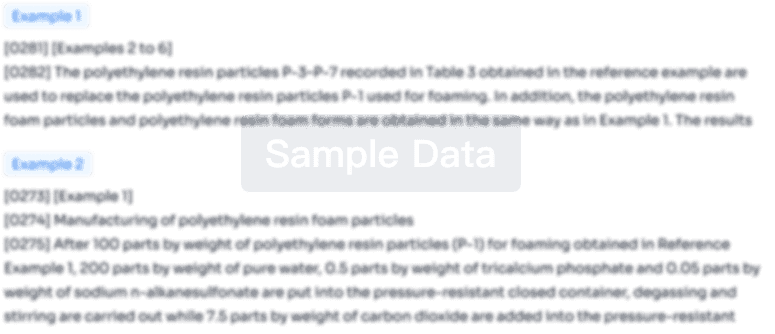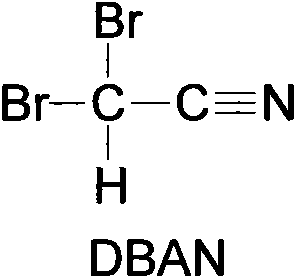Rapid analysis method of disinfection side product dibromo-acetonitrile in drinking water
A rapid analysis, dibromoacetonitrile technology, applied in the field of municipal water supply and drainage and environmental engineering, to achieve the effect of improving recovery rate and enrichment multiple
Inactive Publication Date: 2009-10-21
TONGJI UNIV
View PDF0 Cites 12 Cited by
- Summary
- Abstract
- Description
- Claims
- Application Information
AI Technical Summary
Problems solved by technology
[0008] my country's new "Drinking Water Hygienic Standards" (GB 5749-2006) stipulates that drinking water contains 0.05-4.0mg/L residual chlorine (Cl 2 ), before determining DBAN, Cl 2 eliminated to avoid its impact on DBAN (Cl 2 Oxidation of DBAN), it is necessary to add a chlorination reaction ter
Method used
the structure of the environmentally friendly knitted fabric provided by the present invention; figure 2 Flow chart of the yarn wrapping machine for environmentally friendly knitted fabrics and storage devices; image 3 Is the parameter map of the yarn covering machine
View moreImage
Smart Image Click on the blue labels to locate them in the text.
Smart ImageViewing Examples
Examples
Experimental program
Comparison scheme
Effect test
 Login to View More
Login to View More PUM
 Login to View More
Login to View More Abstract
A rapid analysis method of dibromo-acetonitrile comprises sample pre-treatment, instrument condition control and operation measurement. The method is specifically characterized in that in the sample pre-treatment process, adjusting the pH in a range of 4.5-5.0, using any one of ascorbic acid, sodium thiosulfate, sodium sulphite and ammonium chloride as a chlorination reaction termination agent, using any one of methyl tertiary butyl ether, ethyl acetate, normal hexane and normal pentane as an extraction agent, using a gas chromatography-mass spectrum instrument as a main instrument for detecting DBAN, controlling the sample size to be 3 microlitres, and controlling the temperature at the feeding opening at 110-130 DEG C. The analysis method of the invention improves the pre-treatment method of liquid-liquid extraction, establishes a high-efficiency extraction method, and improves recovery rate and enrichment times of the DBAN. The analysis technique can be widely applied to detection of yielding water in large, medium and small feed water treatment plants, to water quality security check for drinking water production units of bottled water and barrelled water, and to the industries with special water quality requirements and water drinking hygienic monitoring and investigation department.
Description
technical field [0001] The invention belongs to the field of municipal water supply and drainage and environmental engineering, and relates to water quality detection and analysis technology. Background technique [0002] Disinfection of drinking water began in the early 19th century. At that time, chlorine was used as a disinfectant. It can effectively kill microbial pathogens in water and greatly reduce the chance of people dying from water-borne diseases such as dysentery and cholera caused by drinking water. A major breakthrough in the history of health. However, drinking water disinfection has two sides. While improving water quality and eliminating aquatic diseases, it also produces a series of disinfection by-products (Disinfection by-products, DBPs) that are harmful to humans. Disinfection by-products of drinking water refer to compounds produced by the reaction of disinfectants used for drinking water disinfection with some natural organic matter (Nature Organic Ma...
Claims
the structure of the environmentally friendly knitted fabric provided by the present invention; figure 2 Flow chart of the yarn wrapping machine for environmentally friendly knitted fabrics and storage devices; image 3 Is the parameter map of the yarn covering machine
Login to View More Application Information
Patent Timeline
 Login to View More
Login to View More IPC IPC(8): G01N1/28G01N30/02G01N30/72
Inventor 楚文海高乃云徐斌庞维海
Owner TONGJI UNIV
Features
- R&D
- Intellectual Property
- Life Sciences
- Materials
- Tech Scout
Why Patsnap Eureka
- Unparalleled Data Quality
- Higher Quality Content
- 60% Fewer Hallucinations
Social media
Patsnap Eureka Blog
Learn More Browse by: Latest US Patents, China's latest patents, Technical Efficacy Thesaurus, Application Domain, Technology Topic, Popular Technical Reports.
© 2025 PatSnap. All rights reserved.Legal|Privacy policy|Modern Slavery Act Transparency Statement|Sitemap|About US| Contact US: help@patsnap.com



